
View of the Plaza de San Francisco of Havana in 1841 by James G. Sawkins.
This is a list of the preserved important buildings in Havana, capital of Cuba.
Havana was called by the Spanish as the "Key to the New World", and due to the British invasion attempts the Spanish greatly fortified it.
The colonial coat of arms represented the first three main castles of the city and a key.
The "Old Havana and its Fortification System" is a UNESCO World Heritage Site since 1982.
Colonial
| Name | Image | Built | Architectural style | Architect(s) | Belonged to the religious order | |||||||||
|---|---|---|---|---|---|---|---|---|---|---|---|---|---|---|
| Castle de la Real Fuerza (and the La Giraldilla statue) (today houses a Museum of Navigation) |  | 1558-1577 | It is considered to be the oldest stone fort in the Americas | Bartolomé Sánchez |
| |||||||||
| Castle of the Three Magi Kings of Morro |  | 1585-1589 | Fortress | Battista Antonelli |
| |||||||||
| Castle San Salvador de la Punta (it houses the Castle Museum) |  | 1589-1630 | Fortress | Battista Antonelli |
| |||||||||
| Castle del Príncipe | .jpg.webp) | 1767-1771 | Fortress | Silvestre Abarca |
| |||||||||
| Fortress of San Carlos de la Cabaña (it also houses Museum of Fortifications and Weapon) |  | 1763-1774 | it is the third-largest fortress complex in the Americas |
| ||||||||||
| Havana Cathedral | .jpg.webp) | 1748-1777 | Baroque | Society of Jesus |
| |||||||||
| Basilica of San Francisco de Asís |  | 1548-1738 | Baroque | Franciscans |
| |||||||||
| Palace of the General Captains of Cuba (today it houses the Museum of the City) | .jpg.webp) | 1776-1792 | Cuban Baroque | It was the seat of the Spanish governors (Captains General), later the former City Hall. It is the most notable Colonial Baroque work in Havana |
| |||||||||
| Royal Shipyard of Havana |  | 17th century | According to the UNESCO, Havana Royal Shipyard in the 18th century developed the most complete dockyard in the New World.[1] | |||||||||||
| Palace of the Counts of Santovenia (today houses the Hotel Santa Isabel) |  | completed in 1784 | Neoclassical | Julián F. Martínez de Campos Count of Santovenia |
| |||||||||
| Palace del Segundo Cabo | 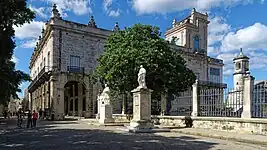 | 1770-1791 | Cuban Baroque | Antonio Fernández de Trebejos y Zaldívar |
| |||||||||
| Arch of Belén |  | 1775 | Baroque | master builder Pedro Medina | Bethlehemites |
| ||||||||
| Convent of Nuestra Señora de Belén |  | late 16th century-1718 | Baroque | bishop Diego Evelino de Compostela | Bethlehemites |
| ||||||||
| Church and Hospital of San Francisco de Paula | 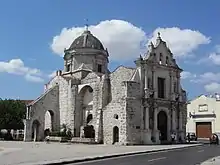 | 1664-1745 | Baroque |
| ||||||||||
| San Carlos and San Ambrosio Seminary |  | 1700-1767 (only the front was redesign to face the bay in 1950) | Baroque | Society of Jesus | ||||||||||
| Church del Espíritu Santo | 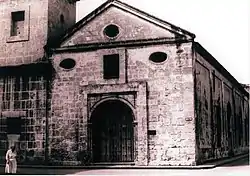 | 1635-1863 | Baroque | Franciscans |
| |||||||||
| Church Santo Cristo del Buen Viaje | .jpg.webp) | 1604-1693 | Neoclassical | Bishop Diego Evelino de Compostela | Third Franciscan Order |
| ||||||||
| Palace of the Counts of Casa Bayona |  | completed in 1720 | built by the Governor of Cuba Don Luis Chacón y Castellón for his son-in-law the 1st Count of Casa Bayona |
| ||||||||||
| Palace of the Marquises of Aguas Claras | 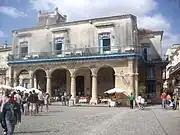 | 1760-1773 | Baroque | Sebastián Peñalver y Angulo, Antonio Ponce de León y Moroto lawyer of the Reales Audiencias of Mexico and Santo Domingo |
| |||||||||
| Palace of the Count of Lombillo | .jpg.webp) | completed in 1741 | Baroque | Pedroso family |
| |||||||||
| Militia Headquarters of Havana (today is part of the Museo Nacional) |  | 1764 | Baroque |
| ||||||||||
| Palace of the Marquis of San Felipe y Santiago de Bejucal (today it is the Hotel San Felipe) |  | 18th century | Baroque |
| ||||||||||
| Palace of the Counts of Jaruco |  | completed in 1739 | Baroque | Don Gabriel Beltrán de Santa Cruz Count of San Juan de Jaruco |
| |||||||||
| Torreón de la Chorrera |  | 1646-1770 | Fort-Tower |
| ||||||||||
| Castle of Atarés |  | 1763-1767 | hexagonal hilltop fort |
| ||||||||||
| Torreón de Cojímar |  | 1640-1763 | tower-fort |
| ||||||||||
| Albear Aqueduct |  | 1861-1893 | Colonel Francisco de Albear y Lara |
| ||||||||||
| Morro Castle Lighthouse |  | 1845 |
| |||||||||||
| Palacio de Aldama |  | 1840 | Neoclassical | Manuel José Carrera |
| |||||||||
| Palace of the Marchioness of Villalba |  | 1875 | Neoclassical | Eugenio Rayneri y Sorrentino |
| |||||||||
| Teatro Martí |  | 1884 | Neoclassical |
| ||||||||||
| Hotel Inglaterra |  | 1875-1886 | Neoclassical | Manuel López y González Urbano, Francisco Villamil |
| |||||||||
| Royal Tobacco Factory Partagás |  | completed in 1845 | Spanish Jaime Partagás |
| ||||||||||
| Teatro Payret (now it is the Cine-Teatro Payret) |  | completed in 1877 | Catalan Joaquín Payret |
| ||||||||||
Demolished Colonial
| Name | Image | Built | Architect(s) |
|---|---|---|---|
| Few remains of the old City Walls of Havana |   _04.jpg.webp) | 1671-1740 (demolished between 1863 and early 20th century) | Francisco Rodríguez de Ledesma, others |
| Convent of San Juan de Letrán |  | second half of 18th century-1777 (demolished between 1919 and 1950s) | Ignacio José Balboa |
| Puertas de Montserrrate |  | The two Puertas de Monserrate were the main entrance to the city walls (demolished between 1863 and early 20th century) | |
| The House of Charity and Maternity of Havana |  | 1687-1792 (demolished between 1959 and 1982, under Fidel Castro regime) | Francisco Vambitelli, Diego Evelino Hurtado de Compostela, Don Luis de Peñalver |
| Plaza del Vapor |  | 1835 (demolished in 1959 under Fidel Castro regime) | Francisco Martí |
| Tacón Theatre |  | 1838 (demolished in 1913) | This theater is remembered because the Italian inventor of the world's first telephone Antonio Meucci, was commissioned and rebuilt the Gran Teatro de Tacón, in the years that he lived in Havana.[2][3] |
Colonial in the nearby towns
| Town | Name | Image | Built | Architectural style | Architect(s) | |||||||
|---|---|---|---|---|---|---|---|---|---|---|---|---|
| Church of Santa María del Rosario | Santa María del Rosario, Cotorro. Its 20 km from Havana. |  | 1760-1766 | Neoclassical |
| |||||||
Post-colonial
| Name | Image | Built | Architectural style | Architect(s) | Location | ||||||||
|---|---|---|---|---|---|---|---|---|---|---|---|---|---|
| El Capitolio |  | 1926-1929 | Neoclassical | Eugenio Rayneri Piedra |
| ||||||||
| Museum of the Revolution (former Presidential Palace) |  | 1920 | Eclectic | Rodolfo Maruri and the Belgian Paul Belau |
| ||||||||
| Great Theater of Havana |  | 1914 | Belgian architect Paul Belau |
| |||||||||
| Hotel Raquel |  | completed in 1908 | Baroque Revival | Venezuelan Paulino Naranjo Ferrer |
| ||||||||
| Lonja del Comercio building |  | 1907-1909 | Neo-Renaissance, Eclectic | Spanish Tomás Mur, José Toraya |
| ||||||||
| Hotel New York (former Cuban Telephone Company building) |  | completed in 1927 | Neo-Plateresque | Cuban Leonardo Morales Pedroso |
| ||||||||
| National Museum of Fine Arts of Havana | 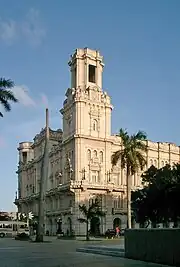 | 1913 | Colonial Revival | Alfonso Rodríguez Pichardo |
| ||||||||
| Havana Central railway station |  | 1910-1912 | Neo-Plateresque | Kenneth MacKenzie Murchison |
| ||||||||
| Hotel Sevilla | .jpg.webp) | 1908 | Moorish Revival | Arellano and Mendoza |
| ||||||||
| Bank of Nova Scotia Building |  | 1906-1914 | Neoclassical |
| |||||||||
| Bacardi Building |  | 1930 | Art Deco | Cuban Esteban Rodríguez-Castells and Rafael Fernández Ruenes |
| ||||||||
| Manzana de Gómez (now it is a Kempinski hotel) |  | 1890-1918 | Don Pedro Tomé y Veracruisse |
| |||||||||
| Floridita |  | 1817-1940s | The origin of Daiquiri was highly linked with the Floridita bar. |
| |||||||||
| Tropicana Club |  | 1939 | A cabaret |
| |||||||||
| Parish of the Sagrado del Corazón de Jesús y San Ignacio de Loyola | .jpg.webp) | 1914-1923 | Neo-Gothic | Spanish Jesuits, Eugenio Dediot |
| ||||||||
| Hotel Ambos Mundos | .jpg.webp) | early 20th century | Eclectic | Spanish merchant Antolín Blanco Arias |
| ||||||||
| Los Balcones de Oficios (now it is another hotel) |  | completed in 1920 | Baroque Revival |
| |||||||||
| Terminal Sierra Maestra | .jpg.webp) | completed in 1914 | Spanish Revival | Barclays Parsons and Klapp for Port of Havana Docks |
| ||||||||
| Hostal Chez Nous La Habana (now it is a hotel) | .jpg.webp) | completed in 1904 | Colonial Revival |
| |||||||||
| Palacio de las Ursulinas |  | completed in 1913 | Neo Mudéjar | José Toraya |
| ||||||||
| Palacio de los Matrimonios (formerly the Spanish Casino) | .jpeg.webp) | completed in 1914 | Neo-Renaissance |
| |||||||||
See also
References
- ↑ "Old Havana and its Fortification System". UNESCO World Heritage List website.
- ↑ Catania, Basilio (December 2003). "Antonio Meucci, l'inventore del telefono" (PDF). Notiziario Tecnico Telecom Italia (in Italian). pp. 109–117. Archived from the original (PDF) on 2 July 2007.
- ↑ Meucci, Sandra. Antonio and the Electric Scream: The Man Who Invented the Telephone, Branden Books, Boston, 2010; ISBN 978-0-8283-2197-6, pp. 15–21, 24, 36–37, 47–52, 70–73, 92, 98, 100.
This article is issued from Wikipedia. The text is licensed under Creative Commons - Attribution - Sharealike. Additional terms may apply for the media files.